-
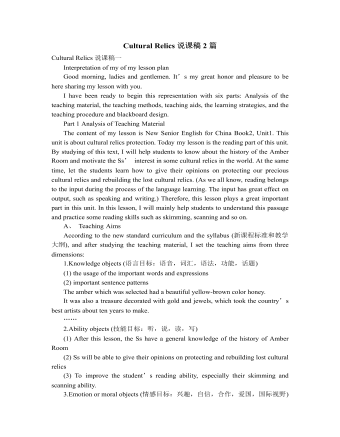
人教版高中英语必修2Cultural Relics说课稿2篇
Ⅲ. Analysis of the teaching material:The topic of this unit is cultural relics. Students are quite interested in topics about different cultures around the world. This is the second period of the whole unit. As a reading class, the passage mainly talks about the history of the amber room (how it was made, sent as a gift, lost and rebuilt).According to the new national curriculum, when teaching reading, much emphasis should be put on training the students’ reading skills.Ⅳ. Teaching objectives1. Language objectives:1) Students are required to master the key words and phrases occurred in the passage (e.g. amazing, decorate, belong, in return, less than etc.)2) Students are required to learn the attributive clause and acquire the sentence pattern.2. 1) Students are required to describe a certain thing by using the new sentence patterns.2) Students are required to master two kinds of reading skills—skimming and scanning, and learn to use them in their daily reading.3. 1) Students are required to know the history of the amber room.2) Students are required to appreciate cultural relics and understand the importance of protecting them.Ⅴ. Teaching important and difficult points1) the new words, phrases, and sentence pattern in the course of reading.2) Teaching difficult point: Help the students master two kinds of reading skills—skimmingand scanning and learn to apply them in daily use.Ⅵ. Teaching methods:Task-based method & Top-down model Ⅶ. Teaching aids: PPT, pictures, blackboard Ⅷ. Teaching procedure:
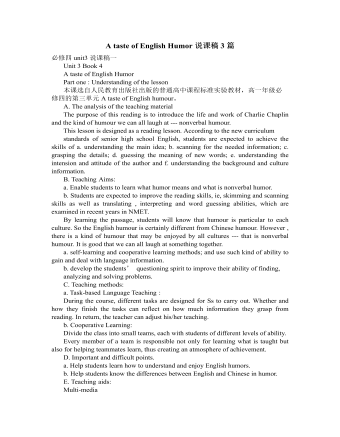
人教版高中英语必修4A taste of English Humor说课稿3篇
Then I would ask them to think of a funny English or Chinese and tell it to partners. While telling stories, they can use expressions and some acting to help make the story funny. 5 minutes would be given to do this.Those stories they told there will be the material for their writing. Soletting them tell it at first is helpful. And they can make a difference between telling a funny story and writing it down. Generally speaking, it is difficult forstudents to write well because they don’t know what to write and how to write. Asking them to tell their own stories at first can help them come up with what to write.After their telling, I would invite someone to share his/her story with all of us and I would write it down on the blackboard.This example story would be used as a sample to illustrate the format of funny story. Different from a story from teacher or textbook, a story from students can obviously become a interesting material to draw students’ attention.Then I would ask the whole class to put this story into several parts. It might be a little bit difficult for them. So I would ask them to find out whether all the sentences are necessary. After delete some sentences, there are 6 sentences left behind. Then they can easily put them into three parts. After interaction with students, I would teach them the right terms for each part and conclude the format of funny story.This step is the key and difficult point in my lesson. So I mainly usetask-based teaching method in this part and the task for students was divided into several stages. With the separated difficult level, students can find there are usually three parts in writing. They can also learn to write without the unnecessary parts in the process of analyzing. And then I wouldn’t rush to tell them the right terms to them directly. Instead, I would ask them to name them by their own. A confused mind is better for acquiring knowledge.While-writing:Then I would give students 7 minutes to write down this story, without other requirements.With all the preparations in pre-writing, students’ difficulties were cleared. So it would be much easier for them to write down the story within 7 minutes. There are no other requirements because students’ first writing is actually a drafting. It would be revise and edit several times later. Writing, as a skill
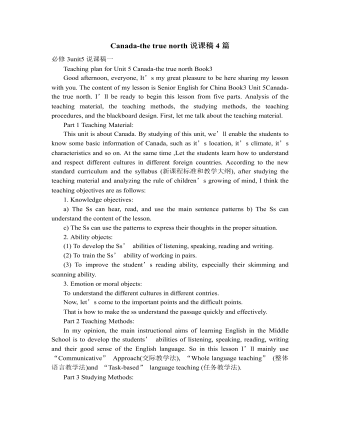
人教版高中英语必修3Canada-the true north说课稿4篇
Good afternoon, teachers, It’s my great pleasure to be here sharing my lesson with you.The content of my lesson is Senior English Book 3 Unit 5 Canada —— “The true North”.I’ll be ready to begin this lesson from five parts. Analysis of the teaching material,the teaching methods,the studying methods, the teaching procedure,and Blackboard design.First, let me talk about the teaching material.Part 1 Teaching Material:This unit is about the introduction of Canada. By studying of this unit,we’ll enable the students to learn the geography, population, main cities, and natural beauty, natural resources of Canada. Through the training of the unit, it also requires students to learn some Language skills such as the expressions of position and emotions.So it plays an important part in the English teaching in this book.After studying the teaching material and analyzing the rule of children’s growing of mind,I think the teaching aims are the followings:1.Knowledge objects:(1) make the students learn some new words and phrases(2) make the students understand the content of the lesson.2.Ability objects:(1)To develop the Ss’ abilities of listening, speaking, reading and writing. Especially reading and speaking ability.(2) learn to talk about the characters of Canada in English(3)To train the Ss’ ability of working in pairs.3.Emotion objects:(1)Enable students to understand the characters of Canada..(2)Stimulate Ss to work hard to make China stronger.Part 2 Teaching Methods:I think helping students learn to master new words and phrases and improve the students’ reading and speaking ability is import and the difficult.According to the analysis of the teaching material and the import points and the difficult points,I will use the following teaching methods : question-guiding approach; fast-reading and careful reading; multi-media teaching methods; discussion
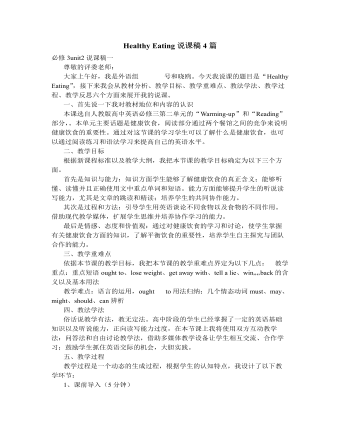
人教版高中英语必修3Healthy Eating说课稿4篇
Language learning needs a context, which can help the learners to understand the language and then can product comprehensible output, so computer has the advantages to make the materials attractive.Part 3 Learning MethodsTask-based, self-dependent and cooperative learningPart 4 Teaching ProcedureStep One Lead-in“Interest is the best teacher.” Therefore, at the very beginning of the class, I should spark the students’ mind to focus on the centre topic “the band”. I’ll show some pictures of food to attract their attention and then bring some questions.Question:What kind of food they like?What should go into a good meal?The answers must relate to the diet. After this, the students will be eager to know something about a balance diet and this is the very time to naturally lead the class into Step 2Step 2 Reading for information: skimming and scanning In this step, I use Task-based Language Teaching method, which can give students a clear and specific purpose while skimming and scanning the context.Task 1 General ideaThe students will be asked to just glance at the title and the pictures of the passage, and then guess what they will read in the text. And they’ll be divided into groups of four to have a discussion.The purpose is to inspire the students to read actively, not passively. In addition, the task is to develop the students’ reading skill by making prediction and to encourage the students to express their thoughts in English and cooperate with each other.Task 2 Main idea of each paragraphCooperative learning can raise the students’ interest and create an atmosphere of achievement. Based on this theory, I divide the whole class into 4 groups to skim the whole text and get the main idea of each paragraph.
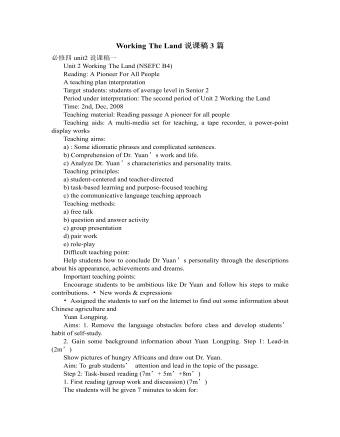
人教版高中英语必修4Working The Land说课稿3篇
Knowledge objectives:(1) to make Ss grasp the usage of words, expressions and sentence structures: statistics, struggle, thanks to, rid of, some patterns for persuasion, the “ing” form as subject and object;(2)to use learnt knowledge to persuade sb.Ability objectives:(1) to develop Ss’ reading skills(skimming, scanning, word guessing);(2) to improve Ss’ speaking, communicating and cooperating skills.Emotional objectives:to make Ss know the contribution of Yuan,and learn his spirit and his simple life time.Teaching important and difficult points:(1) some words, expressions and sentence structures mentioned above;(2)the content of the text;(3)training their reading and speaking skills.Teaching methods: CLT, TBLT,QT.Learning strategies: CLS, QLS, TBLS.Teaching procedures:Step 1 lead-in: (1) teacher plays a piece of recent news from CCTV about the harvest of the super hybrid rice, and ask students whether they know Yuan or not, and talk about him and his contribution.(2)Brain storm: let Ss describe Yuan in their minds including his appearance, his living condition and so on.Step 2 fast reading tasks:(1)teacher introduces Yuan and super hybrid rice(2)make Ss read the text as fast as possible with questions. Such as: what’s the general ideaof this passage? What’s Yuan’ dream? (skimming and scanning skill)Step 3 intensive reading tasks(1)let Ss read the text silently, find topic sentence of each paragraph and draw the difficult sentences and the knowledge what they don’t understand.(words guessing)(2)teacher and Ss talk about the important words, expressions and sentences together, and ask Ss to retell the content of the text.(summarizing and paraphrasing)(3)teacher summarize this part.(4) read again following the courseware.

人教版高中英语必修5Life in the Future说课稿5篇
Good afternoon, everyone. It’s my great pleasure to be here sharing my lesson with you. The content of my lesson is Senior English for China Book5 Unit 3 Life in the Future. I’ll be ready to begin this lesson from six parts: Analysis of the teaching material, Analysis of the students, Teaching aims and important and difficult points, Teaching methods and aids, Teaching procedures, and Blackboard design. First, let me talk about the teaching material.Part 1 Analysis of the Teaching Material:This unit is about what human beings’ life will be like in about one thousand years. By studying of this unit, we’ll Enable the students to know the changes in humans’ life and some new inventions bringing about the change and develop the interest in science. This lesson plays an important part in the English teaching in this unit. This is an important lesson in Book Five. From this lesson, it starts asking the Ss to grasp contents of each passage. Therefore, this lesson is in the important position of the teaching material. If the Ss can learn it well, it will be helpful to make the Ss learn the rest of this unit.Part 2 Analysis of the SsAs Senior2 Ss, they are at different levels of English fluency, some of them have lost interest in English. So during the lesson, I arrange a variety of activities to let all of them join in to attract their interest and let them be confident and taste the joy of success.
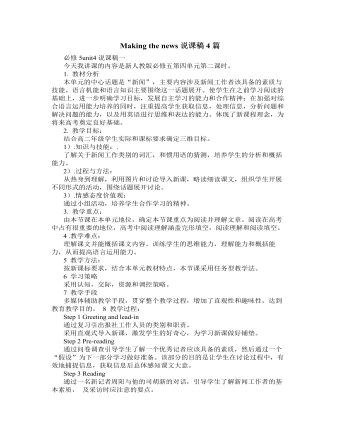
人教版高中英语必修5Making the news说课稿4篇
今天我们来介绍一下必修五第四单元的授课方式。这个单元的题目是Making the news。应该是学生比较感兴趣的话题,学生往往对新闻工作充满好奇,所以我们可以利用这个机会多设计一些师生互动和学生互动,来激发起学习的积极性,提高学习效率。同时我们可以利用这个单元不仅帮助学生掌握语言知识,培养语言能力,同时让其了解新闻工作的重要性,培养起社会智能感。这个单元分为六个课时,它的教学目标是这样的:语言目标是掌握词汇表中的常用单词和短语,掌握倒装句的一些基本用法。 技能目标是能初步掌握约会的基本句型并在真实的场景下正确运用。新闻报道类文章的写作技能。采访的基本规范和沟通技能。情感目标是对新闻报道的客观性和真实性有更好的理解。对新闻记者的职业有更深入的了解,并能体会其工作的重要性。下面我们来介绍一下第一课时的授课方式,第一课的教学目标是这样的第一课时的教学目标语言目标:单词:Occupation, journalist, editor, photographer, curious, personality, enthusiasm
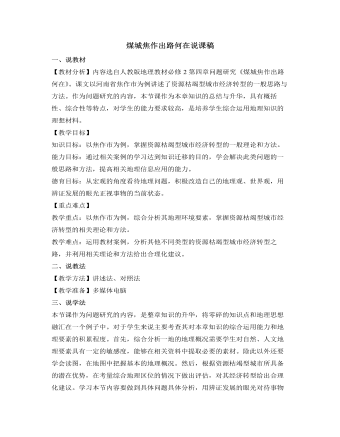
人教版高中地理必修2煤城焦作出路何在说课稿
分析过焦作市的地理概况和产业优势后,就需要针对由于资源枯竭所带来的问题提出合理化的建议。既然是谈经济转型,就应该将话题的范围明确在这一领域内。通过材料3的相关内容,我们了解到焦作市需要在产业结构调整、培育新的优势产业、增强综合竞争力等三个整改方针上下功夫。因而引导学生针对优势与不足提出建议,以三个整改方针为基准,衡量建议的可行性是锻炼学生解决此类问题的有效途径。在此我将教会学生的是解决问题方法而非案例的内容,正所谓“授之以鱼,不如授之以渔”。接下来针对学生的建议和教材资料分析所罗列的10点整改思路,由学生自由发言提出看法,通过教师的指导和学生的讨论,进而确定经济转型建议的具体方案。最后注意将建议与产业优势相对照,看建议是否都是围绕着产业优势而提出的,这样做会加深学生的印象,通过建议和优势的对应关系,将不难找出此类问题的解题思路。
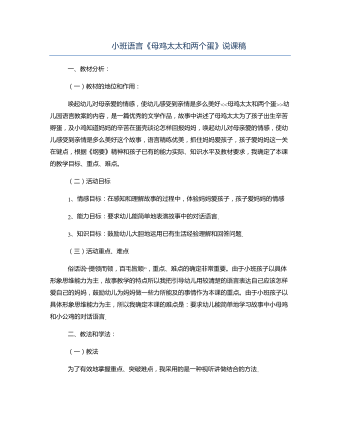
小班语言《母鸡太太和两个蛋》说课稿
唤起幼儿对母亲爱的情感,使幼儿感受到亲情是多么美好<<母鸡太太和两个蛋>>幼儿园语言教案的内容,是一篇优秀的文学作品,故事中讲述了母鸡太太为了孩子出生辛苦孵蛋,及小鸡知道妈妈的辛苦在蛋壳谈论怎样回报妈妈,唤起幼儿对母亲爱的情感,使幼儿感受到亲情是多么美好这个故事,语言精练优美,抓住妈妈爱孩子,孩子爱妈妈这一关在键点,根据《纲要》精神和孩子已有的能力实际、知识水平及教材要求,我确定了本课的教学目标、重点、难点。1、情感目标:在感知和理解故事的过程中,体验妈妈爱孩子,孩子爱妈妈的情感2、能力目标:要求幼儿能简单地表演故事中的对话语言.3、知识目标:鼓励幼儿大胆地运用已有生活经验理解和回答问题.
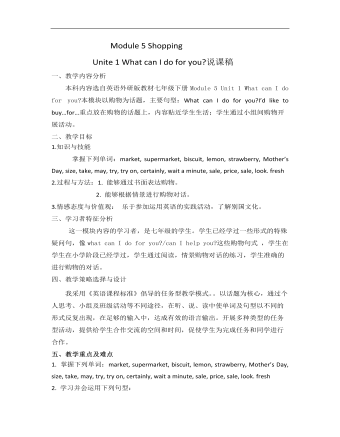
初中英语外研版七年级下册《Module 5 Shopping》说课稿
二、教学目标1.知识与技能掌握下列单词:market, supermarket,biscuit, lemon, strawberry, Mother’s Day, size, take, may, try, try on,certainly, wait a minute, sale, price, sale, look. fresh2.过程与方法:1. 能够通过书面表达购物。2. 能够根据情景进行购物对话。3.情感态度与价值观:乐于参加运用英语的实践活动,了解别国文化。
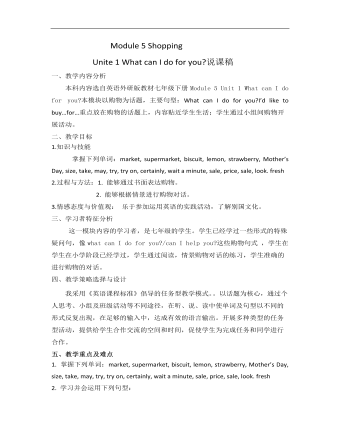
初中英语外研版七年级下册《Module 5 Shopping》说课稿
二、教学目标1.知识与技能掌握下列单词:market, supermarket,biscuit, lemon, strawberry, Mother’s Day, size, take, may, try, try on,certainly, wait a minute, sale, price, sale, look. fresh2.过程与方法:1. 能够通过书面表达购物。2. 能够根据情景进行购物对话。3.情感态度与价值观:乐于参加运用英语的实践活动,了解别国文化。三、学习者特征分析这一模块内容的学习者,是七年级的学生。学生已经学过一些形式的特殊疑问句,像what can I do for you?/can I help you?这些购物句式 ,学生在学生在小学阶段已经学过,学生通过阅读,情景购物对话的练习,学生准确的进行购物的对话。
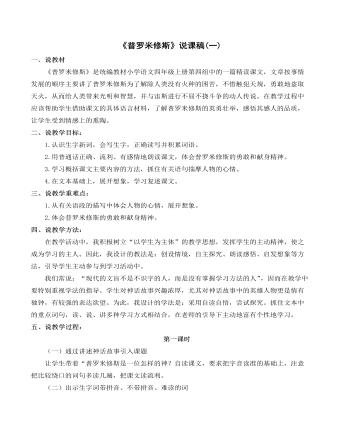
(新)部编人教版四年级上册《普罗米修斯》说课稿(一)
四、说教学方法: 在教学活动中,我积极树立“以学生为主体”的教学思想,发挥学生的主动精神,使之成为学习的主人。因此,我设计的教法是:创设情境,自主探究、朗读感悟、启发想象等方法,引导学生主动参与到学习活动中。 我们常说:“现代的文盲不是不识字的人,而是没有掌握学习方法的人”,因而在教学中要特别重视学法的指导。学生对神话故事兴趣浓厚,尤其对神话故事中的英雄人物更是情有独钟,有较强的表达欲望。为此,我设计的学法是:采用自读自悟,尝试探究。抓住文本中的重点词句,读、说、讲多种学习方式相结合,在老师的引导下主动地富有个性地学习。
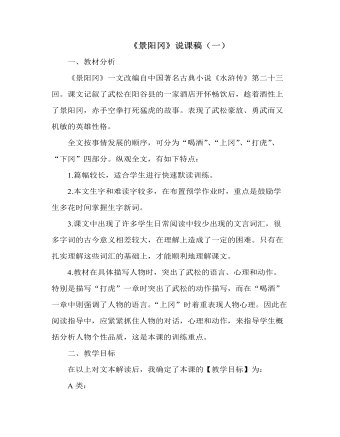
部编人教版五年级下册《景阳冈》说课稿(一)
全文按事情发展的顺序,可分为“喝酒”、“上冈”、“打虎”、“下冈”四部分。纵观全文,有如下特点:1.篇幅较长,适合学生进行快速默读训练。2.本文生字和难读字较多,在布置预学作业时,重点是鼓励学生多花时间掌握生字新词。3.课文中出现了许多学生日常阅读中较少出现的文言词汇,很多字词的古今意义相差较大,在理解上造成了一定的困难。只有在扎实理解这些词汇的基础上,才能顺利地理解课文。4.教材在具体描写人物时,突出了武松的语言、心理和动作。特别是描写“打虎”一章时突出了武松的动作描写,而在“喝酒”一章中则强调了人物的语言。“上冈”时着重表现人物心理。因此在阅读指导中,应紧紧抓住人物的对话,心理和动作,来指导学生概括分析人物个性品质,这是本课的训练重点。
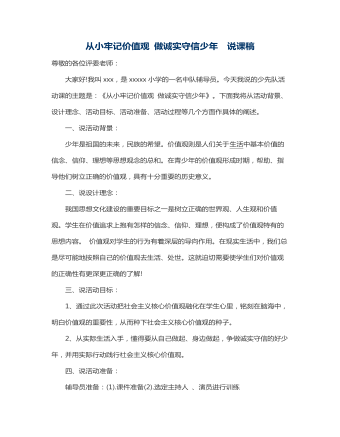
从小牢记价值观 做诚实守信少年-说课稿
尊敬的各位评委老师:大家好!我叫xxx,是xxxxx小学的一名中队辅导员。今天我说的少先队活动课的主题是:《从小牢记价值观 做诚实守信少年》。下面我将从活动背景、设计理念、活动目标、活动准备、活动过程等几个方面作具体的阐述。 一、说活动背景: 少年是祖国的未来,民族的希望。价值观则是人们关于生活中基本价值的信念、信仰、理想等思想观念的总和。在青少年的价值观形成时期,帮助、指导他们树立正确的价值观,具有十分重要的历史意义。 二、说设计理念: 我国思想文化建设的重要目标之一是树立正确的世界观、人生观和价值观。学生在价值追求上抱有怎样的信念、信仰、理想,便构成了价值观特有的思想内容。价值观对学生的行为有着深层的导向作用。在现实生活中,我们总是尽可能地按照自己的价值观去生活、处世。这就迫切需要使学生们对价值观的正确性有更深更正确的了解! 三、说活动目标: 1、通过此次活动把社会主义核心价值观融化在学生心里,铭刻在脑海中,明白价值观的重要性,从而种下社会主义核心价值观的种子。 2、从实际生活入手,懂得要从自己做起、身边做起,争做诚实守信的好少年,并用实际行动践行社会主义核心价值观。 四、说活动准备: 辅导员准备:(1).课件准备(2).选定主持人 、演员进行训练 (3).准备队旗等教具。 (4)收集社会主义核心价值体系内涵外延的材料等 学生准备:(1)搜集身边关于诚实守信的故事或行为 (2)初步了解什么是社会主义核心价值观,
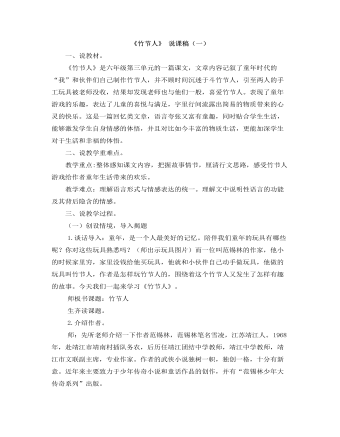
部编人教版六年级上册《竹节人》说课稿(一)
一、说教材。《竹节人》是六年级第三单元的一篇课文,文章内容记叙了童年时代的“我”和伙伴们自己制作竹节人,并不顾时间沉迷于斗竹节人,引至两人的手工玩具被老师没收,结果却发现老师也与他们一般,喜爱竹节人。表现了童年游戏的乐趣,表达了儿童的喜悦与满足,字里行间流露出简易的物质带来的心灵的快乐。这是一篇回忆类文章,语言夸张又富有童趣,同时贴合学生生活,能够激发学生自身情感的体悟,并且对比如今丰富的物质生活,更能加深学生对于生活和幸福的体悟。二、说教学重难点。教学重点:整体感知课文内容,把握故事情节,厘清行文思路,感受竹节人游戏给作者童年生活带来的欢乐。教学难点:理解语言形式与情感表达的统一。理解文中说明性语言的功能及其背后隐含的情感。
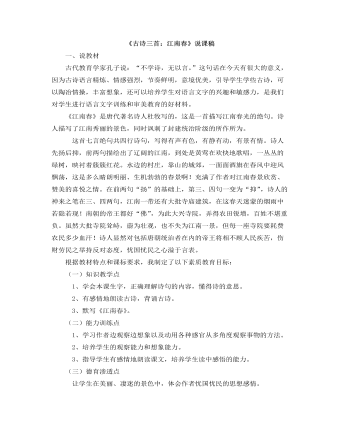
部编人教版六年级上册《古诗三首:江南春》 说课稿
在这样的情境下,学生情趣盎然,紧接着把学生带进新课,点击课件出示配景诗《江南春》,板书课题,齐读课题。接着检查学生的预习情况,每一上新课之前,我都要求学生进行预习,以此来培养学生独立自学能力和良好的学习习惯。然后让学生尝试说说,从题目中,你知道了什么?或你想知道什么?根据学生所说的和所提的,老师归纳总结出有价值的内容和问题,以便在学习古诗中深入渗透探究解决问题。(二)知诗人,介绍写作背景让学生把课前收集到的资料对诗人进行简介及介绍写作背景。这样不仅可以培养其收集处理信息的能力,又培养了口头表达能力及听说能力,又为理解古诗内容做好了准备,同时帮助其获取成功的体验,培养他们主动学习的品质。
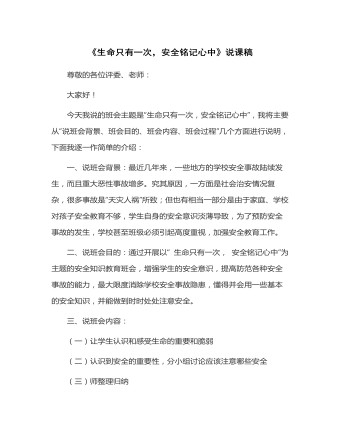
《生命只有一次,安全铭记心中》说课稿
(五)课堂小结四、说班会过程:(一)谈话导入:小朋友们,你知道世界上最珍贵的是什么吗?(生命)当有同学回答说是生命时,师说:“对,就是生命!生命对于我们每个人来说只有一次,所以生命是最可贵的,但是它又是最脆弱的,有时会在那不经意的一瞬间,生命的泉水便会永远消失,所以,本次班队课,老师想和你们一起讨论一下如何爱惜生命、注意安全。”(二)出示一些安全事故的资料 视频和图片资料师过渡:近些年来,发生在学生中的安全事故很多,造成了多少学生死亡,拆散了多少个幸福的家庭,使多少父母痛不欲生!下面请同学们看看这些视频和图片资料(以上设计意图是通过学生视觉和听觉的感官,切身感受生命很脆弱、安全很重要,激发他们提高安全意识)
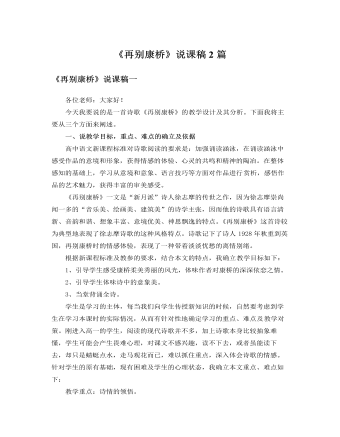
人教版高中语文必修1《再别康桥》说课稿2篇
一、教材分析1、教学对象分析《再别康桥》的教学对象是高一学生,高一学生往往对那种纯粹的、原始的、本真的情感体会较为肤浅,《再别康桥》是新月派诗人徐志摩的传世之作,有极高美学价值,它所抒发的离愁别绪是人类共同的情感经历,通过诵读容易将学生带人诗境,唤醒他们沉寂的真情,从而引起强烈的共鸣。 2、教材地位及作用 高中语文第一册第一单元为诗歌单元,本单元收录了中国现当代的一些优秀诗篇。《再别康桥》安排在本单元的第二课,属于必读课。虽然本诗向来众说纷纭,但其艺术之美人所共知,培养学生高尚的审美情趣和良好的审美创造力是语文学科的任务,因此,从语言赏析入手,从情感体验切入,就可以让学生通过学习本课体会现代诗歌的特点,多方面感受体悟诗歌的情感,受到美的熏陶。
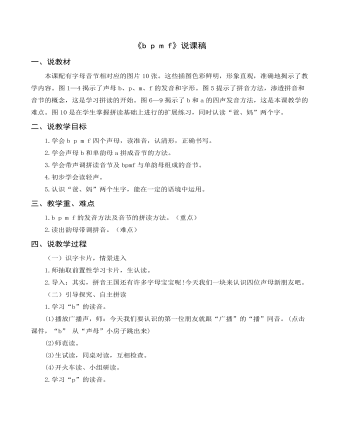
部编人教版一年级上册《b p m f》说课稿
一、说教材本课配有字母音节相对应的图片10张。这些插图色彩鲜明,形象直观,准确地揭示了教学内容。图1—4揭示了声母b、p、m、f的发音和字形。图5提示了拼音方法,渗透拼音和音节的概念,这是学习拼读的开始。图6—9揭示了b和a的四声发音方法,这是本课教学的难点。图10是在学生掌握拼读基础上进行的扩展练习,同时认读“爸、妈”两个字。二、说教学目标1.学会b p m f四个声母,读准音,认清形,正确书写。2.学会声母b和单韵母a拼成音节的方法。3.学会带声调拼读音节及bpmf与单韵母组成的音节。4.初步学会读轻声。5.认识“爸、妈”两个生字,能在一定的语境中运用。三、教学重、难点1.b p m f的发音方法及音节的拼读方法。(重点)2.读出韵母带调拼音。(难点)四、说教学过程(一)识字卡片,情景进入1.师抽取前置性学习卡片,生认读。2.导入:其实,拼音王国还有许多字母宝宝呢!今天我们一块来认识四位声母新朋友吧。? (二)引导探究、自主拼读1.学习“b”的读音。(1)播放广播声,师:今天我们要认识的第一位朋友就跟“广播”的“播”同音。(点击课件,“b” 从“声母”小房子跳出来)
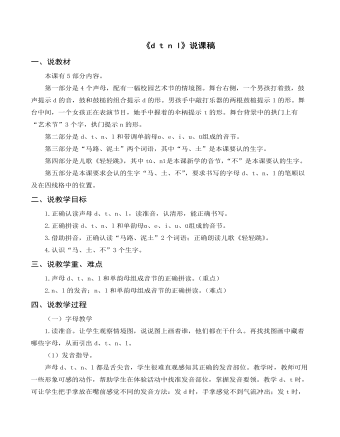
部编人教版一年级上册《d t n l》说课稿
(2)编儿歌练发音。教师要尽可能地利用与d、t、n、l发音相似的“的、特、呢、了”,编成儿歌,帮助学生较快地掌握发音要领。特别是声母n和l,初学时不少学生很容易混淆,可以编一些顺口溜,帮助学生加以区别。2.识记形。(1)观察字形。教师引导学生再次细致观察情境图,说一说d、t、n、l的形体各自有什么特点。告诉学生:d就像鼓和鼓槌组合在一起的样子,t就像女孩手中握着的伞柄,n就像舞台背景拱门的样子,l就像男孩手中的鼓槌。(2)形近字母辨析。d、t、n与前一课所学的b、f、m形体有相似之处,学生很容易混淆。可以让学生通过合作探究的学习方式,弄清它们之间的区别。在学生掌握读音后,出示d、t、n与b、f、m,让他们细细观察,反复比较,小组讨论得出它们的不同点:左下半圆是d,右下半圆是b,一根鱼竿是t,一根拐杖是f,一个门洞是n,两个门洞是m。教师还可以在课堂上展示雨伞实物:伞柄朝上就是t,伞柄朝下就是f。也可以启发学生编顺口溜,帮助记忆新学的字母,如,小鼓敲响ddd,伞柄朝上ttt,一个门洞nnn,一根小棍lll。

